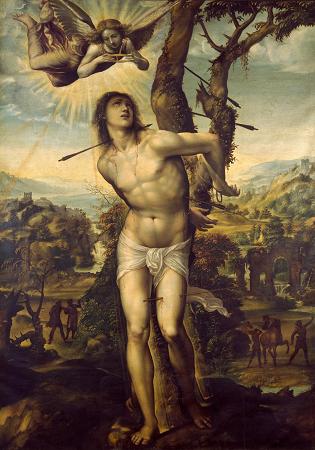Saint Sebastian. Saint Sebastian was an early Christian saint and martyr. According to traditional belief, he was killed during the Roman emperor Diocletian's persecution of Christians, initially being tied to a post or tree and shot with arrows, though this did not kill him. He was, according to tradition, rescued and healed by Saint Irene of Rome, which became a popular subject in 17th-century painting. In all versions of the story, shortly after his recovery he went to Diocletian to warn him about his sins, and as a result was clubbed to death. He is venerated in the Roman Catholic Church and the Orthodox Church. The details of Saint Sebastian's martyrdom were first spoken of by 4th-century bishop Ambrose of Milan, in his sermon on Psalm 118. Ambrose stated that Sebastian came from Milan and that he was already venerated there at that time. Saint Sebastian is a popular male saint, especially today among athletes. In historical times he was regarded as a saint with a special ability to intercede to protect from plague, and devotion to him increased greatly when plague was active. The first surviving account of Sebastian's life and death is the Passio Sancti Sebastiani, long thought to have been written by Ambrose of Milan in the 4th century, but now regarded as a 5th-century account by an unknown author. This includes the two martyrdoms, and the care by Irene in between, and other details that remained part of the story. According to Sebastian's 18th-century entry in Acta Sanctorum, still attributed to Ambrose by the 17th-century hagiographer Jean Bolland, and the briefer account in the 14th-century Legenda Aurea, he was a man of Gallia Narbonensis who was taught in Mediolanum. In 283, Sebastian entered the army in Rome under Emperor Carinus to assist the martyrs. Because of his courage he became one of the captains of the Praetorian Guards under Diocletian and Maximian, who were unaware that he was a Christian. According to tradition, Marcus and Marcellian were twin brothers from a distinguished family and were deacons. Both brothers married, and they resided in Rome with their wives and children. The brothers refused to sacrifice to the Roman gods and were arrested. They were visited by their parents Tranquillinus and Martia in prison, who attempted to persuade them to renounce Christianity. Sebastian succeeded in converting Tranquillinus and Martia, as well as Saint Tiburtius, the son of Chromatius, the local prefect. Another official, Nicostratus, and his wife Zoe were also converted. It has been said that Zoe had been a mute for six years; however, she made known to Sebastian her desire to be converted to Christianity. As soon as she had, her speech returned to her. Nicostratus then brought the rest of the prisoners; these 16 persons were converted by Sebastian. Chromatius and Tiburtius converted; Chromatius set all of his prisoners free from jail, resigned his position, and retired to the country in Campania. Marcus and Marcellian, after being concealed by a Christian named Castulus, were later martyred, as were Nicostratus, Zoe, and Tiburtius. Sebastian had prudently concealed his faith, but in 286 it was detected. Diocletian reproached him for his supposed betrayal, and he commanded him to be led to a field and there to be bound to a stake so that certain archers from Mauritania would shoot arrows at him. And the archers shot at him till he was as full of arrows as an urchin is full of pricks, and thus left him there for dead. Miraculously, the arrows did not kill him. The widow of Castulus, Irene of Rome, went to retrieve his body to bury it, and she discovered he was still alive. She brought him back to her house and nursed him back to health. Sebastian later stood by a staircase where the emperor was to pass and harangued Diocletian for his cruelties against Christians. This freedom of speech, and from a person whom he supposed to have been dead, greatly astonished the emperor; but, recovering from his surprise, he gave orders for his being seized and beaten to death with cudgels, and his body thrown into the common sewer. A pious lady, called Lucina, admonished by the martyr in a vision, privately removed the body, and buried it in the catacombs at the entrance of the cemetery of Calixtus, where now stands the Basilica of St. Sebastian. Remains reputed to be those of Sebastian are housed in Rome in the Basilica Apostolorum, built by Pope Damasus I in 367 on the site of the provisional tomb of Saints Peter and Paul. The church, today called San Sebastiano fuori le mura, was rebuilt in the 1610s under the patronage of Scipione Borghese.
more...














